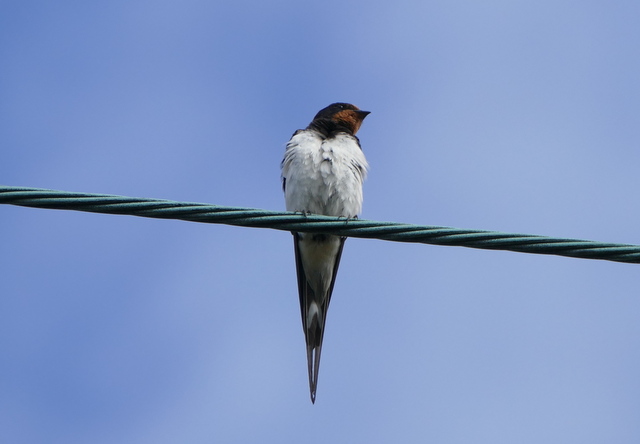Day 2 of a long weekend of tours today. We headed east along the coast to explore the Cley area.
It had been raining rain overnight, and while that had stopped by morning it was still overcast, cool and damp. There were lots of hirundines hawking for inescts over the NWT reserve at Cley as we arrived. A scan through revealed three Swifts amongst them – most of our Swifts appear to have departed already. We decided to head out to the main hides first, given the conditions. We could see lots of waders on the scrapes from the car park.
Unfortunately, just as we were getting ready to leave we spotted the warden in his Land Rover leading the cows off the grazing marsh. One of the herdsmen was walking behind shouting. They made their way right around the edge of the scrapes – needless to say all the waders took flight, departing in all directions. What perfect timing – 9am on a busy Saturday morning, just as all the visitors are about to arrive to see the birds!
We decided to head round to North Scrape instead, which turned out to be a fortuitous decision. As we walked along the beach from the car park, we could see several Gannets passing by offshore in the cool NW wind, and a trickle of Sandwich and Common Terns heading back towards Blakeney Point. We had almost made it to North Scrape when a flash of a white rump ahead of us and a Wheatear landed on one of the larger stones. We stopped to look at it and a second Wheatear flew in next to it. They flicked off along the fence line and as we walked up to the turn to the scrape, we scanned the beach beyond. A different bird was perched up on the fence next to them – slightly smaller, more upright, and with a well-marked pale supercilium, it was a Whinchat. A great way to start the day, with a nice little group of autumn migrants.
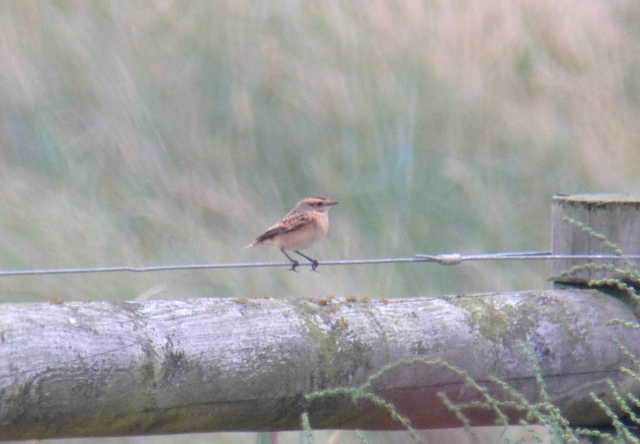 Whinchat – on the fence by North Scrape with a couple of Wheatears
Whinchat – on the fence by North Scrape with a couple of Wheatears
There were lots of waders out on North Scrape – probably quite a few flushed off the rest of the reserve by the warden! Dunlin is the default small wader here, and it is always worth scanning through the flocks to see if there are any other waders with them. There were over 110 Dunlin out feeding on the mud today. In amongst the nearer group, a slightly larger, plumper, darker grey bird stood out – a Purple Sandpiper. More often seen over the winter on the rockier sea defenses around the coast, this was a nice surprise to see here.
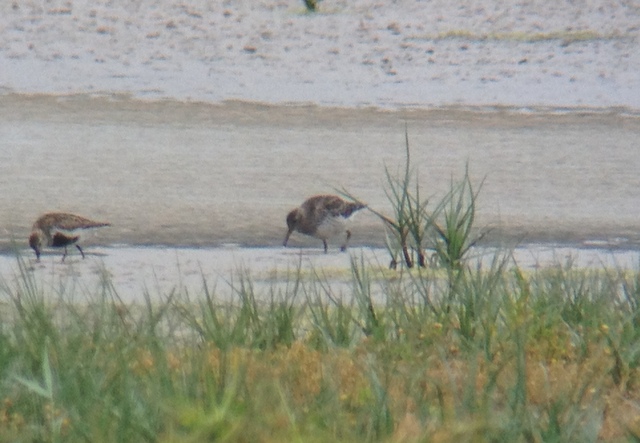 Purple Sandpiper – in amongst the Dunlin on North Scrape
Purple Sandpiper – in amongst the Dunlin on North Scrape
Further back, in amongst a larger flock of Dunlin, we could see a single moulting adult Curlew Sandpiper, its chestnut summer underparts speckled with winter white now. On the edge of the flock, on the drier mud, two much smaller waders were Little Stints, their white faces and bellies obvious even at a distance. We sat patiently, scanning through the mass of birds out on the scrape, and eventually that group came much closer giving us much better views through the scope.
 Curlew Sandpiper – also in amongst the Dunlin
Curlew Sandpiper – also in amongst the Dunlin
There were other waders to find out there as well. A little group of Ringed Plovers were feeding around the edge of one of the islands. A juvenile Knot was down near the front of the scrape at first, half associating with the Dunlin, but happy to do its own thing.
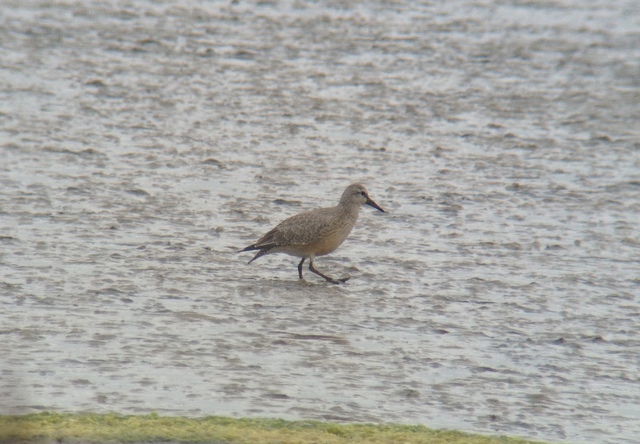 Knot – a juvenile with a light peachy wash to the breast and belly
Knot – a juvenile with a light peachy wash to the breast and belly
We could hear some of the sandpipers, more than we could hear them. There were 2-3 Green Sandpipers but they prefer to feed amongst the vegetation around the edge of the scrapes. Occasionally one would fly round calling and we got one of them in the scope when it stopped to preen in the open. The Wood Sandpiper was less obliging, flying round calling, but dropping down over on Billy’s Wash out of view. The Common Sandpipers were easier to see, feeding around the grassy edges of the islands, bobbing up and down as they did so. A couple of Greenshank performed nicely as well.
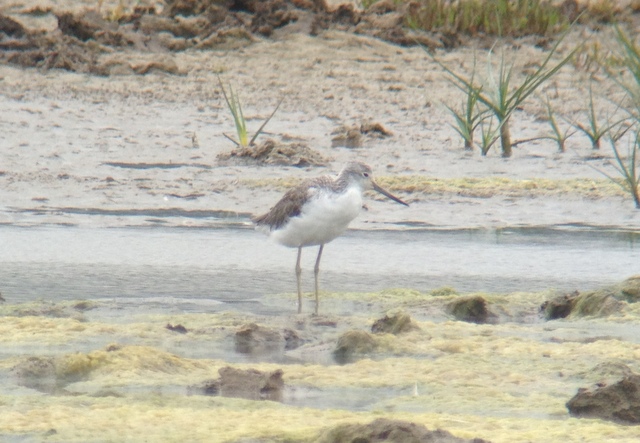 Greenshank – feeding on North Scrape
Greenshank – feeding on North Scrape
In the end, we counted 14 species of wader on North Scrape this morning, including all the more numerous species, such as Black-tailed Godwit, Ruff and Avocet. This was not even counting the Wood Sandpiper and a Turnstone, both of which were only heard overhead and neither of which actually dropped in while we were there. A very respectable score!
We had intended to head back round to the main hides next, but while we were at North Scrape we saw the herdsmen walking round the scrapes again – presumably they had lost one of the herd? With all that disturbance, we decided to head round to the East Bank instead. As we walked back to the car, we scanned the sea. A Common Scoter flew past, along with a few more Gannets. Further out, we picked up a couple of Little Gulls dipping down to the sea, feeding.
It was a bit breezy up on the East Bank. We could hear Bearded Tits pinging, but they were keeping down in the wind – it was not a good day to look for them. Out across the reedbed, we could see one of the juvenile Marsh Harriers perched in a bush – dark chocolate brown body plumage with an orangey town to the crown. It was struggling to stay still in the wind. A second juvenile flew round and more sensibly dropped back down into the shelter of the reeds!
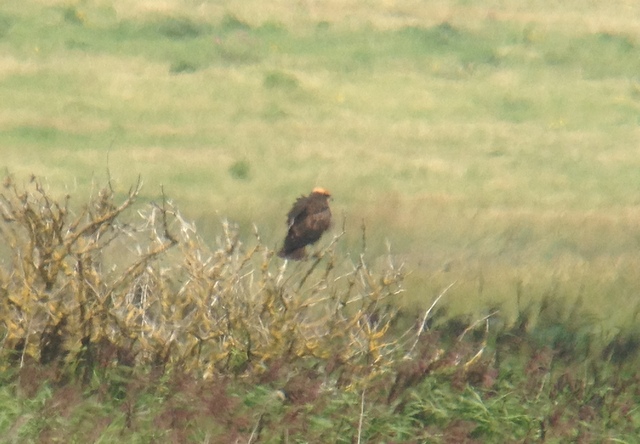 Marsh Harrier – an orangey-headed juvenile was trying to balance on a bush
Marsh Harrier – an orangey-headed juvenile was trying to balance on a bush
There were a few waders out on the Serpentine. Several Black-tailed Godwits were feeding in the deeper water, a mixture of rusty summer plumaged birds and greyer mostly winter individuals and some in between. The Ruff were harder to see, keeping to the grassy edges out of the wind. A Common Sandpiper was similarly lurking amongst the vegetation.
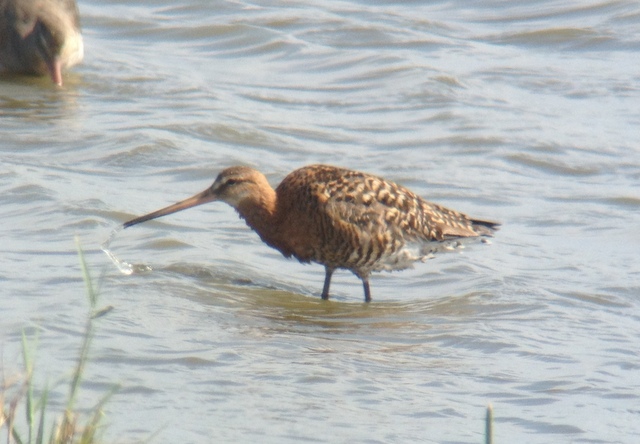 Black-tailed Godwit – several were feeding on the Serpentine
Black-tailed Godwit – several were feeding on the Serpentine
There were fewer waders out on Arnold’s Marsh then in recent weeks. Another large group of Black-tailed Godwits were mostly sleeping, with a couple of Knot in amongst them. The usual gathering of noisy Sandwich Terns was on one of the islands. As we walked back along the East Bank, we did find a couple of Common Darters trying to catch the now emerging sun, despite the breeze.
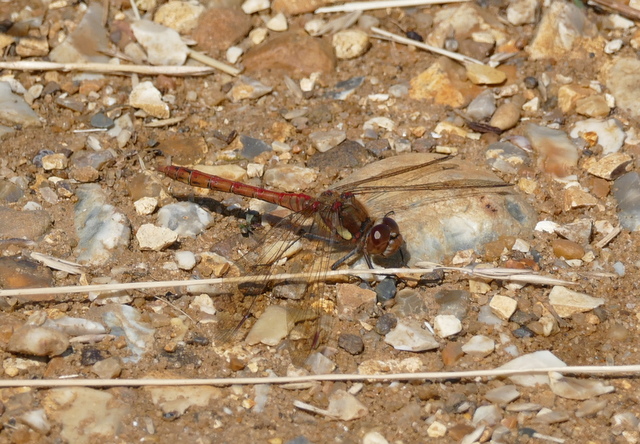 Common Darter – basking on the stones along East Bank
Common Darter – basking on the stones along East Bank
We stopped for lunch at the Visitor Centre. With the weather brightening and the sun out, we were even able to sit outside at the picnic tables. While we were eating, a family of Lesser Whitethroats flew across from the overflow car park and started to feed in the young holm oaks in front us. Very nice lunchtime entertainment!
 Lesser Whitethroat – feeding in the young trees by the picnic tables
Lesser Whitethroat – feeding in the young trees by the picnic tables
After lunch, with the disturbance of the cow herding finally having abated, we headed out to the main hides. On our way, there were lots more Common Darters along the path and a Blue-tailed Damselfly in the reeds along the ditch.
There were still not the number of waders that there had been first thing, but a few of particularly the larger species had made their way back in. The numbers were dominated by Ruff – a mixture of paler, mostly winter-plumaged adults and several browner juveniles – and Black-tailed Godwits. Most of the Black-tailed Godwits we get are from Iceland – of the islandica subspecies. Scanning carefully through the flock, we eventually found a juvenile Continental Black-tailed Godwit – of the limosa subspecies. A nearby juvenile islandica gave a nice opportunity to compare the two.
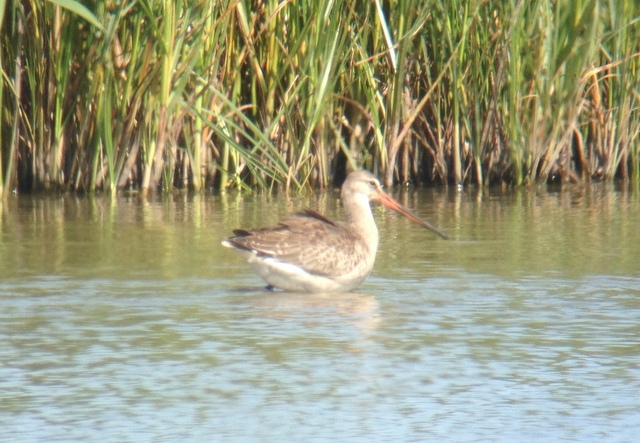 Continental Black-tailed Godwit – a juvenile of the limosa subspecies
Continental Black-tailed Godwit – a juvenile of the limosa subspecies
In amongst a little group of Ruff feeding in the deeper water on Pat’s Pool, we found another Curlew Sandpiper, out second of the day. Again, a moulting adult with white flecked chestnut underparts. A big flock of Lapwing dropped in, presumably flushed of the fields nearby. Another Common Sandpiper was working its way round the islands.
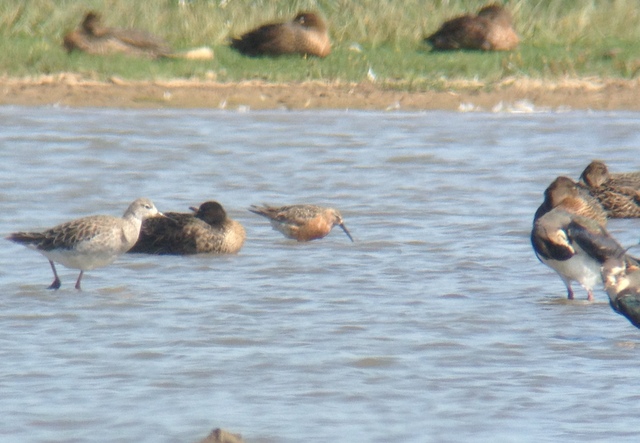 Curlew Sandpiper – our second of the day, this one on Pat’s Pool
Curlew Sandpiper – our second of the day, this one on Pat’s Pool
We still had time left in the day to do one more thing, so we drove round to Kelling and walked down along the track to the Water Meadow. A flock of Long-tailed Tits was feeding in the tall blackthorn hedge. A Chiffchaff was calling from the holly trees along the lane. As we got down to the Water Meadow, a couple of Whitethroat flew out of the hedge. Out on the pool, there were only a handful of waders – two juvenile Ruff, a lone Redshank and a single Ringed Plover. Three Little Egrets were feeding in the shallows.
The wind had now dropped and it was warm in the sunshine. There were several butterflies and dragonflies out now. An Emperor Dragonfly was hawking for insects along the path. As well as a few Gatekeepers and a Speckled Wood along the lane, we came across several Common Blues around the shorter vegetation down on the coast.
There were lots of Goldfinch and Linnets in the brambles on the hillside behind the beach, post-breeding with plenty of juveniles. In amongst the, along the fence line, we came across a little family group of Stonechats. The male perched on the fence preening whilst the juveniles kept dropping down amongst the thistles in the field.The female Stonechat was further up the fence, higher up on the hillside, and while we were watching her a much paler, buffier bird appeared alongside – a Whinchat. It was feeding differently to the Stonechats, flying up above the bushes, hawking for insects. We decided to walk round and up the hill for a better look. Further down the track, out on the Quags, a single Wheatear was feeding in with cows on the shorter grazed grass.
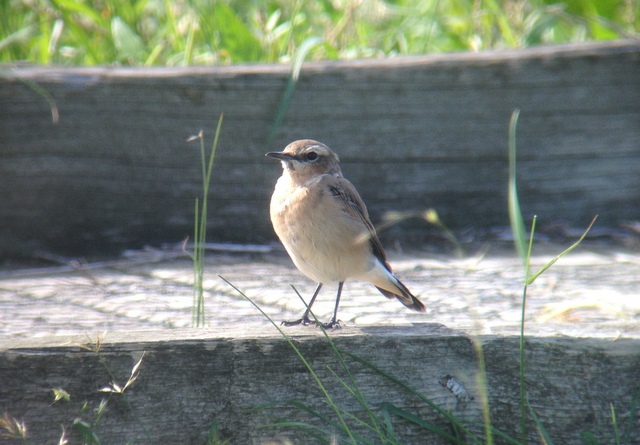 Wheatear – out on the Quags at Kelling
Wheatear – out on the Quags at Kelling
Round on the hillside, we had a great view along the coast and out to sea. We could hear Whimbrel calling and picked up 3 distantly, flying in off the sea before turning and heading east away from us. We could also hear Stonechats calling and could see a couple on the fence ahead of us. Suddenly a Whinchat appeared as well. Before we could get the scope on it, the female Stonechat chased it away down towards the sea. Only when the Stonechats had returned to feeding their youngsters, did the Whinchat return to the fence, before being chased away again.
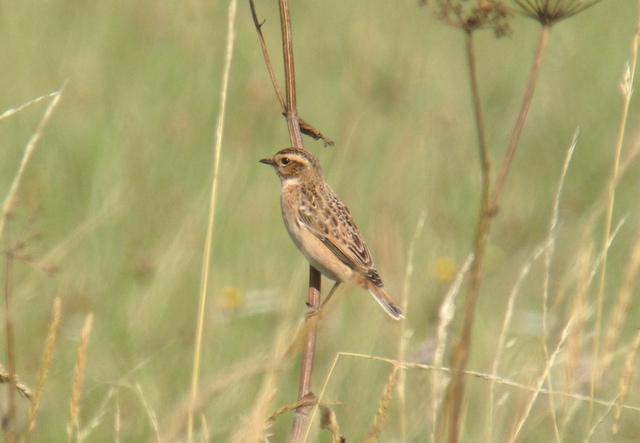 Whinchat – one of two down at Kelling this afternoon
Whinchat – one of two down at Kelling this afternoon
We eventually got a good look at it – when it wasn’t being chased off. Then we turned to head back. As we did so, we saw that the Whinchat we had seen earlier was still flycatching on the other side of the hill – there were actually two present with the Stonechats. As walked back we could hear the Swallows alarm calling and looked up to see a Sparrowhawk shoot through. Another Swallow back in the village was more relaxed, preening on the wires above the car as we packed up for the day.
